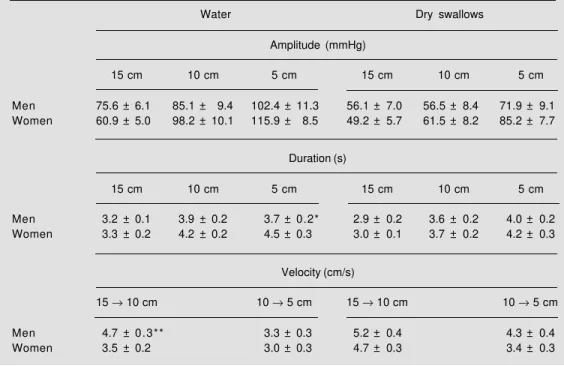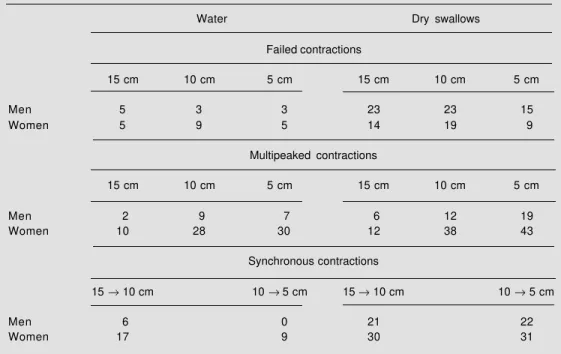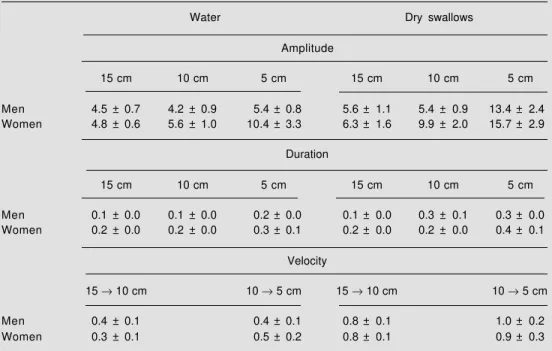Gender effects on esophageal motility
Departamento de Clínica Médica, Faculdade de Medicina de Ribeirão Preto, Universidade de São Paulo, Ribeirão Preto, SP, Brasil
R.O. Dantas, E. Ferriolli and M.A.N. Souza
Abstract
It has been suggested that there are no gender effects on esophageal motility. However, in previous studies the subjects did not perform multiple swallows and the quantitative features of esophageal contrac-tions were not evaluated. In order to investigate the gender effects on esophageal motility we studied 40 healthy normal volunteers, 20 men aged 37 ± 15 years (mean ± SD), and 20 women aged 38 ± 14 years. We used the manometric method with an eight-lumen polyvinyl catheter and continuous perfusion. The upper and lower esophageal sphincter pressures were measured by the rapid pull-through method. With the catheter positioned with one lumen opening in the lower esophageal sphincter, and the others at 5, 10 and 15 cm above the sphincter, ten swallows of a 5-ml water bolus alternated with ten dry swallows were performed. Statistical analysis was done by the Student t-test and Mann-Whitney test. Gender differences (P<0.05) were observed for wet swallows in the duration of contractions 5 cm above the lower esophageal sphincter (men: 3.7 ± 0.2 s, women: 4.5 ± 0.3 s, mean ± SEM), and in the velocity of contractions from 15 to 10 cm above the lower esophageal sphincter (men: 4.7 ± 0.3 cm/s, women: 3.5 ± 0.2 cm/s). There was no difference (P>0.05) in sphincter pressure, dura-tion and percentage of complete lower esophageal sphincter relax-ation, amplitude of contractions, or in the number of failed, multipeaked and synchronous contractions. We conclude that gender may cause some differences in esophageal motility which, though of no clinical significance, should be taken into consideration when interpreting esophageal motility tests.
Correspondence
R.O. Dantas
Departamento de Clínica Médica FMRP, USP
Av. Bandeirantes, 3900 14049-900 Ribeirão Preto, SP Brasil
Fax: 55 (016) 633-6695
Publication supported by FAPESP.
Received October 17, 1997 Accepted January 26, 1998
Key words
•Esophageal motility
•Gender
•Esophageal physiology
Introduction
Human esophageal motility is affected by various factors such as volume (1,2), viscos-ity (3,4), temperature of the bolus swallowed (5,6), body position during deglutition (7,8), and age (4,9).
It has been suggested that gender has no effect on esophageal motility (10,11). How-ever, no systematic study comparing the quan-titative parameters of multiple swallows in males and females is available. In the present investigation we studied esophageal motility
in men and women matched by age using wet and dry swallows.
Material and Methods
Subjects
Informed consent was obtained from each volunteer. The study was approved by the Human Research Committee of Hospital das Clínicas of FMRP-USP.
Esophageal manometry
For esophageal manometry we used a round eight-lumen polyvinyl catheter with an exter-nal diameter of 4.5 mm and an interexter-nal diam-eter of 0.8 mm (Arndorfer Specialties Inc., Greendale, WI). The four distal openings were at the same level, at 90o angles. The four
proximal openings were 5 cm apart from each other, also at 90o angles. The lumens of the
catheter were connected to external pressure transducers (Model RP1500, Narco Bio Sys-tems, Narco Scientific, Houston, TX), which in turn were connected to a four-channel physiograph (Model MK IV, Narco Bio Sys-tems, Narco Scientific). The lumens were per-fused with distilled water at a rate of 0.5 ml/ min through a system of low-compliance con-tinuous perfusion.
The study method was previously de-scribed (4). Briefly, all volunteers were stud-ied in the supine position. The catheter was inserted through the nose into the stomach after an overnight fast. After a 10-min period of stabilization, the pressures of the lower esophageal sphincter (LES) and the upper esophageal sphincter (UES) were recorded using the four distal openings and the rapid pull-through (RPT) technique. For the LES pressure measurement the volunteers were instructed to stop breathing at the end of expiration when the catheter was pulled by hand at the velocity of 1 cm/s. For the UES the volunteers were instructed to stop breath-ing durbreath-ing the movement of the catheter, which was pulled at the same velocity as for the LES. The sphincter pressures were re-corded in triplicate.
The intragastric pressure and intraesoph-ageal pressure were used as reference for the LES and UES pressures, respectively. The results were the mean of the three pressures
measured at the site where they were high-est, and the mean of the twelve values was recorded.
For the study of the esophageal body the catheter was positioned with the more distal of the four proximal openings situated at the level of the LES, and the other proximal openings located at 5, 10 and 15 cm above the LES. In this position the volunteers per-formed 10 swallows of a 5-ml bolus of dis-tilled water at room temperature, alternated with 10 dry swallows. The interval between successive swallows was at least 30 s.
The variables considered were contrac-tile wave amplitude, duration and velocity, as previously described (11). The duration of LES relaxation, in seconds, was measured from the beginning of the descending curve to the beginning of the ascending curve. LES relaxation was complete when its pressure fell to values of less than 4 mmHg above the intragastric pressure. The complete absence of motor activity after a swallow at a given site was considered to be a failure of contrac-tion. Contractions of simultaneous onset at recording sites 5 cm apart, or with a velocity of more than 10 cm/s, were considered syn-chronous. Multipeaked waves occurred when there was more than one peak in the esoph-ageal contraction.
For each volunteer we calculated the pa-rameters as the mean of 10 dry and 10 wet swallows. For the proportions we show the number of events related to the total number of 200 deglutitions in each group. We also calculated the index of variance for each subject, which represents the variance of the ten swallows divided by the mean.
Statistical analysis
The results are reported as mean ± SEM and as number of events.
The Student t-test was used for data
Results
There was no difference (P>0.05) in esophageal contraction amplitude between men and women (Table 1). The duration of contractions was higher in women than in men at 5 cm above the LES after wet swal-lows (P = 0.05). From 15 to 10 cm above the LES, also with wet swallows, the velocity of
contractions was higher in men than in women (P<0.01, Table 1).
Although there was a difference in LES and UES pressures between men and women it was not statistically significant (P>0.05, Table 2).
There was no difference in the duration of LES relaxation (P>0.46), the percentage of deglutitions followed by complete LES
Table 1 - Gender effects on amplitude, duration and velocity of esophageal contractions in men (N = 20) and women (N = 20) after deglutition of a 5-ml bolus of water and dry swallows.
Results are reported as mean ± SEM. *P = 0.05 and **P<0.01 compared with women (t-test).
Water Dry swallows
Amplitude (mmHg)
15 cm 10 cm 5 cm 15 cm 10 cm 5 cm
Men 75.6 ± 6.1 85.1 ± 9.4 102.4 ± 11.3 56.1 ± 7.0 56.5 ± 8.4 71.9 ± 9.1 Women 60.9 ± 5.0 98.2 ± 10.1 115.9 ± 8.5 49.2 ± 5.7 61.5 ± 8.2 85.2 ± 7.7
Duration (s)
15 cm 10 cm 5 cm 15 cm 10 cm 5 cm
Men 3.2 ± 0.1 3.9 ± 0.2 3.7 ± 0.2* 2.9 ± 0.2 3.6 ± 0.2 4.0 ± 0.2
Women 3.3 ± 0.2 4.2 ± 0.2 4.5 ± 0.3 3.0 ± 0.1 3.7 ± 0.2 4.2 ± 0.3
Velocity (cm/s)
15 → 10 cm 10 → 5 cm 15 → 10 cm 10 → 5 cm
Men 4.7 ± 0.3** 3.3 ± 0.3 5.2 ± 0.4 4.3 ± 0.4
Women 3.5 ± 0.2 3.0 ± 0.3 4.7 ± 0.3 3.4 ± 0.3
Table 2 - Lower (LES) and upper (UES) esophageal sphincter pressures in men (N = 20) and women (N = 20) measured by the rapid pull-through method in the direction where it is highest, and by the mean of the four directions.
Results are reported as mean ± SEM in mmHg.
LES UES
Highest Mean Highest Mean
Men 46.3 ± 4.3 28.4 ± 2.5 125.6 ± 9.5 75.7 ± 6.0
Table 3 - Duration of lower esophageal sphincter (LES) relaxation (mean ± SEM) and the percent-age of swallows with complete LES relaxation in men (N = 20) and women (N = 20) after degluti-tion of a 5-ml bolus of water and dry swallows.
LES relaxation Complete LES duration (s) relaxation (%)
Water Dry Water Dry
Men 8.6 ± 0.3 7.4 ± 0.3 99 92
Women 9.0 ± 0.4 7.6 ± 0.3 97 83
Table 4 - Number of failed, multipeaked and synchronous contractions in men (N = 20) and women (N = 20) after 200 deglutitions of water and 200 dry swallows in each group.
Water Dry swallows
Failed contractions
15 cm 10 cm 5 cm 15 cm 10 cm 5 cm
Men 5 3 3 23 23 15
Women 5 9 5 14 19 9
Multipeaked contractions
15 cm 10 cm 5 cm 15 cm 10 cm 5 cm
Men 2 9 7 6 12 19
Women 10 28 30 12 38 43
Synchronous contractions
15 → 10 cm 10 → 5 cm 15 → 10 cm 10 → 5 cm
Men 6 0 21 22
Women 17 9 30 31
functional esophageal motility disorders (12). Using this method we found that men have an increase in the velocity of esoph-ageal peristalsis in the middle part of the esophageal body and a decreased duration of contractions 5 cm above the LES when com-pared with women. The differences, although statistically significant, are probably of no clinical significance. However, we have taken them into consideration when interpreting esophageal motility tests.
There are no gender differences in esoph-ageal functional anatomy or innervation that could explain these small changes in esoph-ageal motility (13,14). Gastric emptying of solid food in young women is slower than in men as a consequence of altered distal gas-tric motor function (15).
These differences in upper gastrointesti-nal motility between men and women may be attributed to reduced gastrointestinal smooth muscle contractility caused by fe-male reproductive hormones (16,17). How-ever, we did not find differences in esoph-ageal amplitude contractions or sphincter pressures.
relaxation (P>0.44, Table 3), or the number of failed (P>0.56), multipeaked (P>0.10) and synchronous contractions (P>0.25, Table 4).
We did not observe significant differ-ences in the index of variance (P>0.10, Table 5).
Discussion
In an experimental study which evalu-ated the effect of chronic administration of ethanol on esophageal motility using the cat as an animal model, it was found that ethanol significantly affected the esophageal con-traction amplitude and LES pressure only in males (18). In vitro studies demonstrated an inhibitory effect of progesterone on the smooth muscle of ureter, large bowel and stomach (16). Another study also demon-strated the inhibitory effect of progesterone on contractile force in rat gastrointestinal smooth muscle (17). Thus, it is possible that hormonal differences between men and
Table 5 - Index of variance of amplitude, duration and velocity of esophageal contractions after the deglutition of a 5-ml bolus of water and dry swallows, in men (N = 20) and women (N = 20).
The index of variance for each subject was the variance of the ten swallows divided by the mean. The results are reported as mean ± SEM of the index of variance for the 20 subjects in each group.
Water Dry swallows
Amplitude
15 cm 10 cm 5 cm 15 cm 10 cm 5 cm
Men 4.5 ± 0.7 4.2 ± 0.9 5.4 ± 0.8 5.6 ± 1.1 5.4 ± 0.9 13.4 ± 2.4
Women 4.8 ± 0.6 5.6 ± 1.0 10.4 ± 3.3 6.3 ± 1.6 9.9 ± 2.0 15.7 ± 2.9
Duration
15 cm 10 cm 5 cm 15 cm 10 cm 5 cm
Men 0.1 ± 0.0 0.1 ± 0.0 0.2 ± 0.0 0.1 ± 0.0 0.3 ± 0.1 0.3 ± 0.0
Women 0.2 ± 0.0 0.2 ± 0.0 0.3 ± 0.1 0.2 ± 0.0 0.2 ± 0.0 0.4 ± 0.1
Velocity
15 → 10 cm 10 → 5 cm 15 → 10 cm 10 → 5 cm
Men 0.4 ± 0.1 0.4 ± 0.1 0.8 ± 0.1 1.0 ± 0.2
Women 0.3 ± 0.1 0.5 ± 0.2 0.8 ± 0.1 0.9 ± 0.3
women may cause changes in digestive mo-tility. Nevertheless, hormones do not have an important role in esophageal motility (13). The results for men and women were virtually the same as previously described (11,12).
References
1. Hollis JB & Castell DO (1975). Effect of dry swallows and wet swallows of differ-ent volumes on esophageal peristalsis. Journal of Applied Physiology, 38: 1161-1164.
2. Vanek AW & Diamant NE (1987). Re-sponses of the human esophagus to paired swallows. Gastroenterology, 92: 643-650.
3. Dooley CP, Schlossmacher B & Valenzuela JE (1988). Effects of alter-ations in bolus viscosity on esophageal peristalsis in humans. American Journal of Physiology, 254: G8-G11.
4. Ferriolli E, Dantas RO, Oliveira RB & Braga FJHN (1996). The influence of ageing on oesophageal motility after ingestion of liq-uids with different viscosities. European Journal of Gastroenterology and Hepatol-ogy, 8: 793-798.
5. Winship DH, Viegas de Andrade SR & Zboralske FF (1970). Influence of bolus temperature on human esophagus motor function. Journal of Clinical Investigation, 49: 243-250.
6. Meyer GW & Castell DO (1981). Human esophageal response during chest pain induced by swallowing cold liquids. Jour-nal of the American Medical Association, 246: 2057-2059.
7. Weihrauch TR, Brummer A, Biewener H
& Ewe K (1980). Assessment of various factors influencing esophageal pressure measurement. I. Significance of method-ological factors in intraluminal manom-etry. Klinische Wochenschrift, 58: 279-285.
8. Kaye MD & Wexler RM (1981). Alteration of esophageal peristalsis by body posi-tion. Digestive Diseases and Sciences, 26: 897-901.
9. Khan TA, Shragge BW, Crispin JS & Lind JF (1977). Oesophageal motility in the eld-erly. American Journal of Digestive Dis-eases, 22: 1049-1054.
10. Weihrauch TR, Vallerius P, Alpers H & Ewe K (1980). Assessment of various fac-tors influencing esophageal pressure measurement. II. Significance of physi-ological factors in intraluminal manom-etry. Klinische Wochenschrift, 58: 287-292.
11. Richter JE, Wu WC, Johns DN, Blackwell JN, Nelson III JL, Castell JA & Castell DO (1987). Esophageal manometry in 95 healthy adult volunteers. Digestive Dis-eases and Sciences, 32: 583-592. 12. Kahrilas PJ, Clouse RE & Hogan WJ
(1994). American Gastroenterological As-sociation technical review on the clinical use of esophageal manometry. Gastroen-terology, 107: 1865-1884.
13. Diamant NE (1993). Physiology of the esophagus. In: Sleisenger MH & Fordtran JS (Editors), Gastrointestinal Disease. WB Saunders Company, Philadelphia. 14. Conklin JL & Christensen J (1994). Motor
functions of the pharynx and esophagus. In: Johnson LR (Editor), Physiology of the Gastrointestinal Tract. Raven Press, New York.
15. Knight LC, Parkman HP, Brown KL, Miller MA, Trate DM, Maurer AH & Fisher RS (1997). Delayed gastric emptying and de-creased antral contractility in normal pre-menopausal women compared with men. American Journal of Gastroenterology, 92: 968-975.
16. Kumar D (1962). In vitro inhibitory effect of progesterone on extrauterine smooth muscle. American Journal of Obstetrics and Gynecology, 84: 1300-1304. 17. Bruce LA, Behsudi FM & Danhof IE
(1978). Smooth muscle mechanical re-sponses in vitro to bethanechol after pro-gesterone in male rat. American Journal of Physiology, 235: E422-E428.


